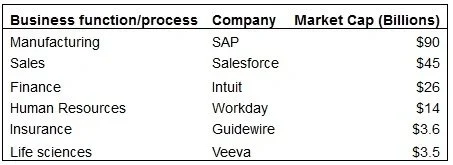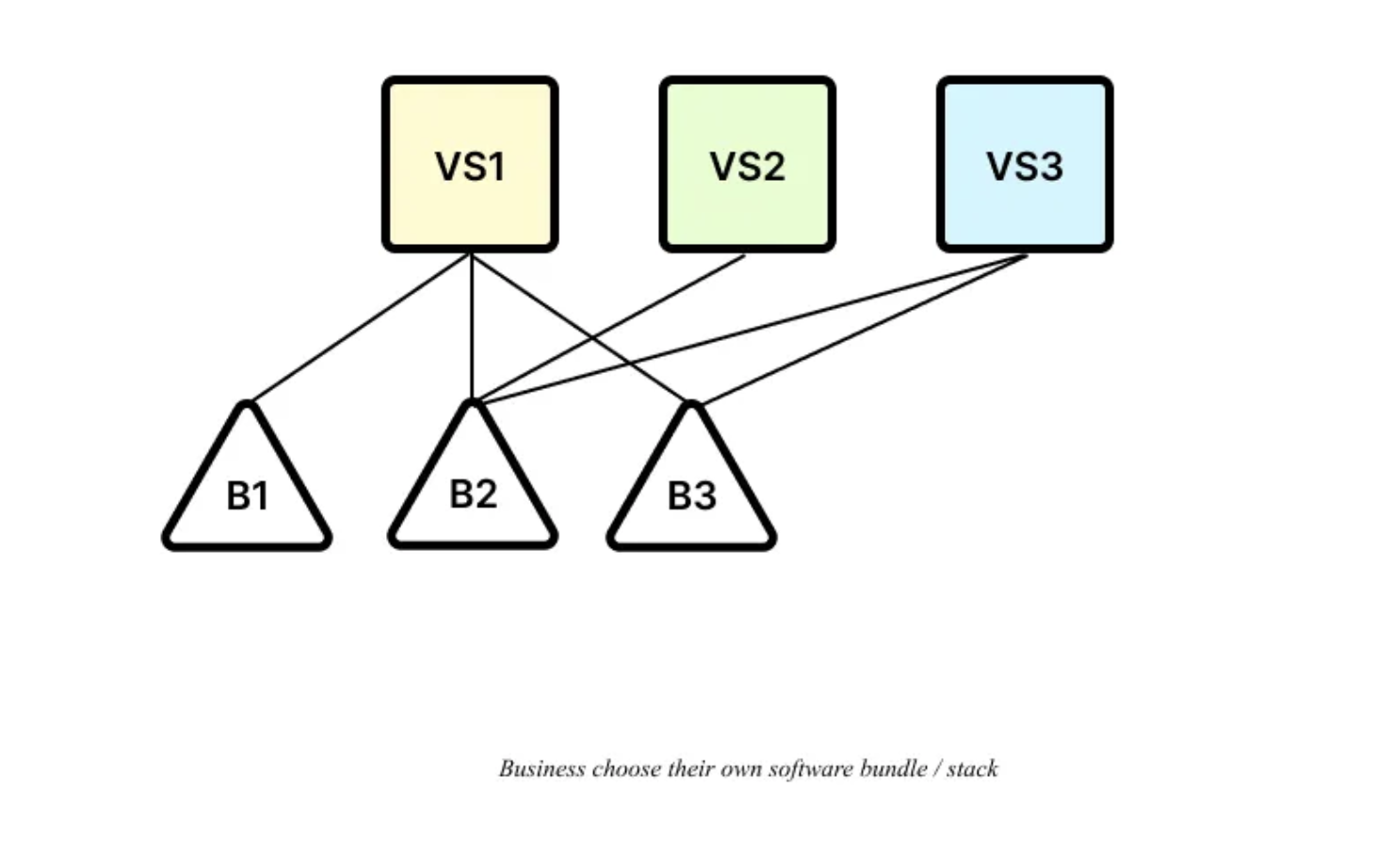04/30/23
Integration SaaS for Systems of Record
“uncool” tech + a primer on systems of record + opportunity to build monopolies
A Primer on System of Record
We live in a world where data is rapidly becoming one of the most valuable assets of organizations. In the digital age, organizations of all sizes and across all industries are generating vast amounts of data every day, from customer information to financial records, supply chain data, and more.
Managing this data can be incredibly challenging. Data can become scattered across multiple platforms, creating silos that make it difficult to access or use. Inaccurate or inconsistent data can cause errors and confusion, and the lack of a centralized repository makes it difficult to ensure compliance with data privacy regulations.
Most organizations use something called a System of Record.
A System of Record is a data management term for an information storage system that is the authoritative data source for a given data element or piece of information. It is the primary source of information that is used to make important decisions and perform critical operations within the organization. A system of record can help organizations achieve these objectives by providing a single source of truth for data and facilitating data integration, management, and analysis.
The most common types of Systems of Record are as follows
ERP (Enterprise Resource Planning) system: An ERP system is a software solution that helps organizations manage various business processes, including finance, accounting, inventory, and human resources. The ERP system acts as a system of record for all of the data related to these processes.
CRM (Customer Relationship Management) system: A CRM system is a software solution that helps organizations manage their interactions with customers and prospects. The CRM system acts as a system of record for all customer-related data, such as contact information, purchase history, and communication history.
EMR (Electronic Medical Record) system: An EMR system is a software solution that helps healthcare organizations manage patient medical records electronically. The EMR system acts as a system of record for all of the data related to patient care, including medical history, medications, lab results, and more.
SCM (Supply Chain Management) system: An SCM system is a software solution that helps organizations manage their supply chain operations, including procurement, inventory, and logistics. The SCM system acts as a system of record for all of the data related to these processes.
HRIS (Human Resources Information System) system: An HRIS system is a software solution that helps organizations manage various HR-related processes, including payroll, benefits administration, and employee data management. The HRIS system acts as a system of record for all of the data related to these processes.
These are just a few examples of systems of record that are widely used across different industries. The specific systems used by an organization may vary depending on their specific needs and processes.
The move to SaaS
Systems of record have been around for a long time, predating the rise of SaaS (Software as a Service) by many years. In fact, many organizations have been using on-premise (on-prem) systems of record for decades to manage critical business functions.
However, with the advent of cloud computing and the increasing popularity of SaaS solutions, many organizations have started to migrate their systems of record to the cloud. This has led to the emergence of cloud-based systems of record, which are often provided as SaaS offerings.
The move to cloud-based systems of record has been driven by several factors, including the scalability and flexibility of cloud infrastructure, the ease of deployment and management of cloud-based solutions, and the cost-effectiveness of using cloud services compared to maintaining on-prem infrastructure.
While systems of record have been around for a long time, the move to cloud-based systems of record has been a more recent trend that has been driven by the growth of SaaS and cloud computing.
VentureBeat published an article in 2016, during the peak emergence of SaaS, that highlighted the key to building a billion-dollar SaaS company: creating a 'system of record'.
2016 – peak emergence period – market caps of companies with powerful systems of record
Systems of record are well-suited for SaaS as they efficiently manage large volumes of data generated by SaaS applications, provide a centralized repository for data, support scalability, facilitate data integration, ensure compliance with data privacy and security regulations, and enable data analysis and reporting for informed decision-making.
Integration SaaS
Integrations play a crucial role in transferring data between different points, and in the current era of AGI and LLMs, they have become even more important. This is because these advanced models require real data for effective training.
B = business, VS = vertical software *via Sara Du
B1 might choose to use just VS1 instead of VS2 and VS3 maybe because they aren’t at the maturity level of B2. Businesses pick and choose their own different software stacks.
The data generated by these models needs to be stored somewhere, and new-age applications must access and interact with this data. Even in the current web3 winter, it is worth noting that integrations remain important. If web3 becomes a significant part of the internet's future, integrations will be vital for connecting web3 apps to each other and to web2. As long as different companies continue to develop new technology applications, integrations will continue to be a crucial component of data management.
A business, B3 (e.g. PR agency) might have vertical software VS1 (e.g. hubspot) and VS3 (e.g. salesforce) in its techstack. There are many permutations and combinations of this, especially when competitors come into play. All illustrated well in this primer.
I’ve noticed that the dominating system of record data management companies are using integration SaaS as a primary driver to build an ecosystem moat.
For example, in 2018, Salesforce acquired Mulesoft (integration cloud-based platform that allows businesses to integrate disparate systems, applications, and data sources across their enterprise) for $6.5 billion in a cash and stock deal. Veeva has in-house APIs and a ton of integration partners, building what they also call an ecosystem. SAP offers a variety of integration technologies, including the Integration Suite, PI/PO, Cloud Platform Integration, and Gateway, that enable businesses to connect their SAP systems with other applications, data sources, and devices.
This might not be completely novel, but understanding the granularity of moats deployed by ultra successful SaaS Systems of Record helps me understand the key factors that contribute to their success, and how these factors can be applied to my job.
Integration SaaS for system of record clicked for me when I read Sara Du’s Integration SaaS primer. She is the co-founder and CEO of Alloy Automation. Through her essay, I understood how important integrations really are to all the SaaS solutions that power so much of what we rely on. And when I think of integration SaaS as a driver for a system of record monopoly, I’m not just thinking of a main platform with a few APIs and integrations, I’m thinking having more so a basic system of record (management system or data platform), but focused on integrating any and every application related to that industry or vertical. The primary value proposition being the integration aspect – integrating VS1, VS2, and VS3 within a simple and sleek data housing system (of record) – for B1, B2 and B3.
Whether on-prem or cloud-hosted, integration SaaS can serve as a powerful first-to-market GTM motion to fuel the success of systems of record for new verticals. For instance, by building an ecosystem moat and/or utilizing network effects.
We might think that the main verticals are already spoken for (healthcare, finance, manufacturing, etc), but we know now that the most groundbreaking ideas are found at the intersection of disparate fields. How To Think Of An Idea.
Maybe the lesson here is that, sometimes it’s cool to build “uncool” tech, because it’s the uncool tech that holds it all together. How can we apply the glue to new emerging technologies? Is now the peak emergence period for uncool billion-dollar tech?
This piece is 30/50 from my 50 days of writing series. Subscribe to hear about new posts.

